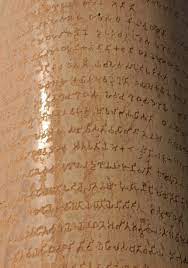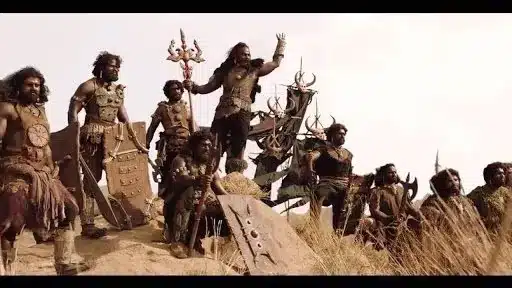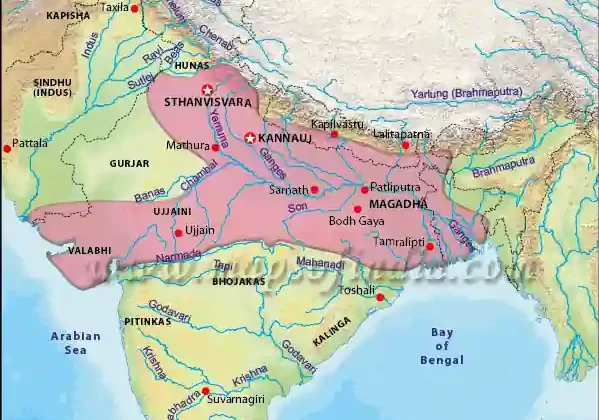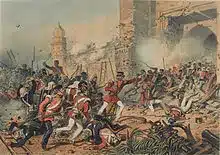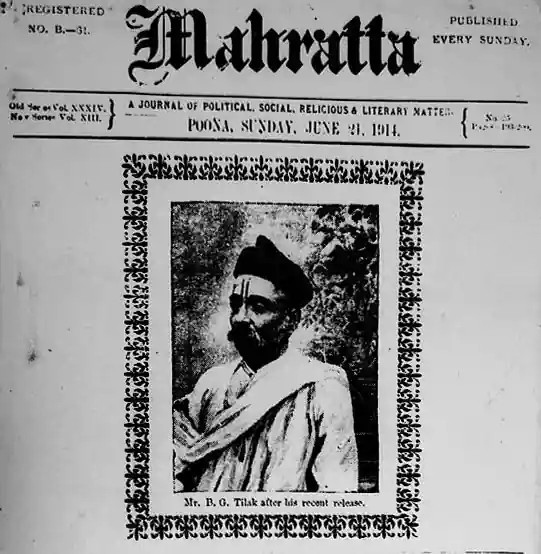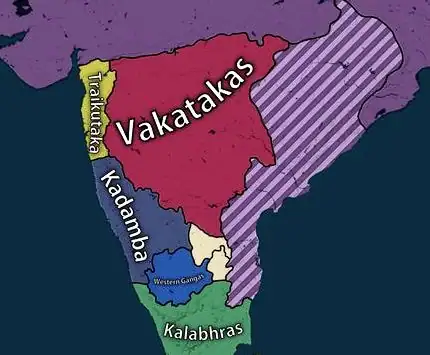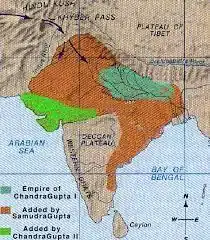Introduction
The Mauryan Empire, which formed around 321 B.C.E. and ended in 185 B.C.E., was the first pan-Indian empire, an empire that covered most of the Indian region. It spanned across central and northern India as well as over parts of modern-day Iran.
Sources of Maurya Empire:
The sources of the Maurya period are more varied and considered more authentic than the earlier periods. For the first time now, we have at our disposal a number of sources (literary sources like Arthashastra of Kautilya, Indica of Megasthenes, and the Junagarh Inscription of Rudradaman I, which attributes to the beginning
of construction of a Sudarshana lake during Chandragupta’s reign), and edicts issued by Ashoka that throw a clearer light on the history of this period.
Indian Sources
- Arthashastra, written by Kautilya – The main theme of the treatise was Statecraft. It was later discovered and translated into English by Shyama Sastri.
- Mudrarakshasa, written by Visakhadatta during the Gupta period- Deals with the diplomacy of Rakshasa, the Prime Minister of Nandas. It describes how Chandragupta with the assistance of Kautilya overthrew the Nandas.
- Kautilya also wrote Chandragupta Katha.
The other major literary sources for the period include
- Hemachandra’s Parishishtaparvan (establishing Chandragupta’s connections with Jainism);
- Dandin’s Dashakumaracharita;
- Banabhatta’s Kadambari;
- the trinity of Buddhist texts that give us an account of Chadragupta’s life, namely, the Mahavamsa, Milindapanho, and Mahabhashya;
- the Buddhist Dipavamsa, Ashokavadana, Divyavadana (these three texts, as well as the Mahavamsa, give us an account of Ashoka);
- the Vamsatthapakasini (a 10th century commentary on the legend of Chanakya and Chandragupta); as well as Mamulanar’s reference to the southward expansion of the Mauryas (according to this Tamil poet of the Sangam period, the Mauryas had an alliance with a southern power located in north Karnataka called the Koshar, and the Mauryas continuously interfered in the affairs and politics of south).
Foreign Sources
- Megasthenes (Greek ambassador in the court of Chandragupta Maurya) book Indica has survived only in fragments. Yet, Indica gives details about the Mauryan administration, particularly the administration of the capital city of Pataliputra and also the military organization. He stated that there were no drinking habits, no slavery, etc. He also divided Indian society into seven castes based on profession. It also stated that the city administration of Pataliputra was managed by a municipal board of thirty members.
- Ptolemy wrote monographs on Geography.
- Pliny, the Elder, wrote monographs on Natural History. He also lamented on the drain of wealth from Rome to India.
- The works of both Ptolemy and Pliny, deals with trade, commerce and communication system under the Mauryas.
Numismatic Evidence
- Coin age started with the Mauryas as they were the first to issue punch-marked (minted) coins.
- Signs on Mauryan coins:
- Peacock, Hiu (influence of Jainism) and Crescent (influence of Ajivikas) were found on Mauryan coins.
- Peacock was representative of Mauryas as it derived from ‘Muryas-tamers’ i.e. who tamed peacocks.
- Important coins were Tola (Gold) and Pana (Silver). Each Pana was equal to ¾th of a Tola.
- Mauryas used to mint coins in Ashada masa (beginning of the financial year).
Rise of the Mauryas
- The last of the Nanda rulers, Dhana Nanda was highly unpopular due to his oppressive tax regime.
- Also, post-Alexander’s invasion of North-Western India, that region faced a lot of unrest from foreign powers.
- Some of these regions came under the rule of the Seleucid Dynasty, founded by Seleucus Nicator I. He was one of the generals of Alexander the Great.
- Chandragupta, with the help of an intelligent and politically astute Brahmin, Kautilya usurped the throne by defeating Dhana Nanda in 321 BC.
Mauryan Polity
Chandragupta Maurya
The Mauryan dynasty was founded by Chandragupta Maurya with the assistance of Chanakya/Kautilya. Chandragupta’s origins are shrouded in mystery. The Greek sources (which are the oldest) mention him to be of non-warrior lineage. The Hindu sources also say he was a student of Kautilya of humble birth (probably born to a Shudra woman). Most Buddhist sources say he was a Kshatriya. It is generally accepted that he was an orphaned boy born into a humble family who was trained by Kautilya.
- Greek accounts mention him as Sandrokottos.
- Justin, a Greek writer, says that Chandragupta Maurya overran the whole of India with an army of 600,000.
- Alexander had abandoned his India conquest in 324 BC and within a year, Chandragupta had defeated some of the Greek-ruled cities in the north-western part of the country.
- He was the chief architect of the Mauryan empire who first established himself in Punjab and then moved eastwards to gain control over the Magadhan region.
- In a series of battles, he defeated Dhana Nanda and laid the foundations of the Maurya Empire in about 321 BC.
- Kautilya provided the strategy while Chandragupta executed it.
- In 305 B.C. he defeated Seleucus Nikator, the representative of Alexander.
- An agreement was reached between the two in 305 B.C. and it was the 1s treaty in Indian history between a native king and a foreign ruler. He also married Seleucus Nicator’s daughter. In return, Seleucus Nicator got 500 elephants.
- Megasthenes was the Greek ambassador at Chandragupta’s court.
- He conquered Saurashtra and appointed Pushyagupta as the Governor. Pushyagupta constructed the famous Sudarshana Lake. It was attested by Rudradaman’s (Greatest of the Sakas) Junagarh inscription.
- He was the first king to envisage the ideas of a Welfare State and paternal kingship (treating his subjects as children).
- He also was the first to take the titles Devampriya (beloved of Gods) and Priyadarshi (one who loves to be admired).
- Mauryans were the first to end the monopoly of Brahmans.
- They were also critical of Divine Kingship.
- Chandragupta led a policy of expansion and brought under one control almost the whole of present India barring a few places like Kalinga and the extreme South.
- His reign lasted from 321 BC to 297 BC.
- He abdicated the throne in favour of his son, Bindusara, and went to Karnataka with Jain monk Bhadrabahu. He had embraced Jainism and is said to have starved himself to death (santhara) according to the Jain tradition at Shravanabelagola.
Bindusara
- Son of Chandragupta.
- He ruled from 297 BC to 273 BC.
- Also known as Amitrochates (destroyer of foes) by the Greek scholars while the Mahabhasya refers to him as Amitraghata (killer of enemies).
- Megasthenes was replaced by Diamachus as the Greek ambassador to the court of Bindusara.
- It is known from the Greek accounts that Bindusara requested the Syrian king Antiochus l Soter, who was the son of Seleukos Nikator, to buy and send to him sweet wine, dried figs and a learned philosopher. And, the Syrian king wrote back: “We shall send you the figs and wine, but in Greece the laws forbid a sophist (a man of wisdom) to be sold”. He, however, sent an ambassador named Daimachus to the court of Bindusara.
- Susima, the eldest of 100 sons was the Governor of Taxila. He failed to suppress the revolt of the guilds in his region. Ashoka, the Governor of Ujjain suppressed the revolt.
- It is believed that Bindusara joined the Ajivika sect.
- Conquered ‘the land between the two seas’, i.e., the Arabian sea and the Bay of Bengal. The Tibetan monk Taranatha (who wrote a 17th century history of Indian Buddhism) states that one of Bindusara’s great lords, Chanakya, destroyed the nobles and kings of 16 towns and made him master of all the territory between the eastern and western seas.
- Under his rule, almost the entire sub-continent (as far south as Karnataka) was under Mauryan suzerainty.
Ashoka, the Great
- There was a four-year succession conflict after the death of Bindusara in 273 BCE. Bindusara wanted his son Susima to succeed him.
- The Ceylonese Chronicles, Dipavamsa and Mahavamsa state that Ashoka killed all his brothers except Tisya and came to power with the support of minister Radhagupta in 273 B.C.
- According to Taranatha of Tibet, Asoka killed only six of his brothers.
- Ashoka acted as Governor of Ujjain and also suppressed a revolt in Taxila during his father Bindusara’s reign.
- Ashoka was one of the greatest kings of all times, and is regarded as the first ruler to maintain direct contact with his people through his inscriptions.
- The other names of the emperor include Buddhashakya (in the Maski edict), Dharmasoka (Sarnath inscription), Devanampiya (meaning beloved of the gods) and Piyadassi (meaning of pleasing appearance) given in the Sri Lankan Buddhist chronicles Dipavamsa and Mahavamsa.
- The Dipavamsa and Mahavamsa give a detailed account of his queens. He was married to Mahadevi (daughter of a merchant of Vidisha) who was the mother of Mahendra and Sanghamitra, the celebrated children of Ashoka who helped in the propagation of Buddhism. The Buddhist texts also mention queens Asandhimitta, Padmavati, Tissarakhita (who tried to cut the Bodhi tree) and Karuvaki (the only queen to be mentioned in the queen’s edict, where she is described as the mother of prince Tivara, the only son of Ashoka to be mentioned by name in inscriptions).
- During Ashoka’s reign, the Mauryan empire covered the whole territory from Hindukush to Bengal, and extended over Afghanistan, Baluchistan and the whole of India including Kashmir and the valleys of Nepal, except a small portion in the far south, which was occupied by Cholas and Pandyas according to the rock edict 13 and by Keralaputras and Satyaputras as per the rock edict 2.
- He developed diplomatic relations with his contemporaries in Syria, Egypt, Macedonia, Cyrenaica (Libya) and Alexander of Epirus, all these are mentioned in the Edicts of Ashoka.
- In his 10th regnal year, he attacked Kalinga. Dimouasi and Meghavahana were the 2 Kalingan kings that fought the war. The main cause for the battle of Kalinga was that the Naga tribes of Kalinga were looting Mauryan ships. Ashoka mentioned the details of Kalinga war at Dhauli in his famous XII Major Rock Edict.
- He was a great proponent of Buddhism. According to tradition, and as mentioned in the Mahavamsa and Dipavamsa, he was converted to Buddhism by his nephew Nigrodha (who had become a monk at the tender age of 7). According to the Divyavadana, Samudra (a merchant-turned-monk) converted him. Buddhism for the first time went outside India during his reign.
- Ashoka appointed Dharma Mahamattas to propagate dharma among various social groups including women (in the 14th year of his reign).
- During his second Dharmayatra tour (in the 21st year of his reign), he visited Lumbini, the birthplace of Buddha.
- He banned animal sacrifice, regulated the slaughter of animals for food and established dharmashalas, hospitals and sarais throughout his kingdom.
- He was converted to Buddhism by Upagupta. He visited the Buddhist shrines and installed the Rumandei Pillar Inscription at Lumbini to mark the nativity of Buddha.
- He introduced a social philosophy called Dhamma (Dharma) with principles like Satya, Samyama, Sankshema and Ahimsa.
- Organised the third Buddhist council at Pataliputra (in the 18th year of his reign), after which he sent Buddhist missionaries to Ceylon and Suvarnabhumi.
Ashoka’s Names
- Ashoka has been mentioned by different names in different texts and edicts. In most of the edicts, he is mentioned as Devanampiya and Piyadassi.
- In Bhabru Inscription, he is mentioned as Piyadassi laja Magadhe (Piyadassi, King of Magadha).
- The Maski edict mentions his name as Asoka while Puranas name him Asokavardhana.
- Girnar Inscription of Rudradaman mentions him as Asoka Maurya.
Later Mauryans
- Dasharatha was the last ruler of the Mauryan dynasty to have issued imperial inscriptions—thus the last Mauryan Emperor to be known from epigraphical sources. Dasharatha is known to have dedicated three caves in the Nagarjuni Hills to the Ajivikas.
- Samprapti: He was the son of Ashoka’s blind son, Kunala and succeeded his cousin, Dasharatha, as emperor of the Maurya Empire. He was the only great Mauryan emperor after Ashoka, and was a great patron of Jainism.
- Brihadratha was the last ruler of the Mauryan Empire. He ruled from 187 to 185 BCE, when he was killed by his general, Pushyamitra Shunga, who went on to establish the Shunga Empire.
Chanakya
- Teacher of Chandragupta Maurya, who was also his Chief Minister.
- He was a teacher and scholar at Taxila. Other names are Vishnugupta and Kautilya.
- He was also a minister in the court of Bindusara.
- He is credited to be the master strategist behind the usurping of the Nanda throne and the rise of the Mauryan Empire through his student, Chandragupta.
- He wrote Arthashastra which is a treatise on statecraft, economics, and military strategy.
- Arthashastra was rediscovered by R Shamasastry in 1905 after it had disappeared in the 12th century.
- The work contains 15 books and 180 chapters. The main theme is divided into:
- King, Council of Ministers and Departments of the Government
- Civil and criminal law
- Diplomacy of war
- It also contains information on trade and markets, a method to screen ministers, spies, duties of a king, ethics, social welfare, agriculture, mining, metallurgy, medicine, forests, etc.
- Chanakya is also called ‘Indian Machiavelli”.
Ashokan Inscriptions
The history of Ashoka is reconstructed on the basis of his inscriptions. He was the first Indian king to speak directly to the people through his inscriptions. These inscriptions throw light not only on the reign of Ashoka, but also reveal his external and domestic policies, his views about dhamma, and the extent of his empire.
There are total 33 inscriptions and are primarily classified into Major Rock Edicts, Minor Rock Edicts, Separate Rock Edicts, Major Pillar Edicts, and Minor Pillar Edicts.
- They are the first written recorded evidences in Indian history.
- They were deciphered for the 1st time by James Princep in 1837.
- The inscriptions were written in Pali language (Prakrit), the exception being Kandahar inscription which is written in Greek and Armaic (Armenian) languages and is hence bilingual.
- The script used in the inscriptions is Brahmi (left to right).
- The only inscriptions written in Kharosti script (right to left) were Manshera and Shabazgiri inscriptions.
- In the Maski and Girjara inscriptions, Asoka reveals his actual name.
- In the Babru Edict, Ashoka expressed his faith in Buddhism.
- In the Barabar cave inscriptions, Ashoka declared his secular policy.
- In the Sarnath pillar inscription, he called himself Dharma-asoka.
- In the Rumandei pillar inscription, Ashoka talks about land grants made to the monasteries and tax concessions given to them.
- In the II and XI separate Rock Edicts, Ashoka elaborates on his Dharma.
Kalinga War Impact
- After his accession to the throne, Ashoka fought only one major war called the Kalinga war. In this war, 100,000 people were killed and 1,50,000 were taken as prisoners.
- The war brought to the Brahmana priests and the Buddhist monks great suffering, which caused Ashoka much grief and remorse. So, he abandoned the policy of physical occupation in favour of a policy of cultural conquest, meaning bherighosha was replaced by dhammagosha (mentioned in the 13th Major Rock Edict). After the Kalinga war, he tried to conquer the foreign dominions ideologically rather than by military conquest.
- Ashoka retained Kalinga after its conquest and incorporated it into his empire. The Kalinga war did not make Ashoka an extreme pacifist, he rather adopted a practical policy of consolidating his empire.
- He repeatedly asked the tribal people to follow the policy of dharma and threatened them not to violate the established rules of social order and righteousness (dharma). He appointed a class of officers – rajukas who were entrusted with the power of administering justice.
- Ashoka converted to Buddhism as a result of the Kalinga war.
Ashoka’s Legacy
Ashoka is considered a great missionary ruler in the history of ancient India, and also of the world. Some of his path-breaking achievements are given below:
- Political unification of the country – He bound the whole country together by one dhamma, one language, and practically one script of Brahmi – which is used in most of his inscriptions.
- Spread of tolerance and respect – He adopted and preached tolerance in religious sphere as well as in case of scripts and languages. He did not try to force his religious faith on his subjects, instead he gave donations to non-Buddhist sects as well (such as donating Barbara caves to the Ajivika sect). He respected scripts other than Brahmi, like Kharoshti, Aramaic and Greek.
- Promotion of cultural contacts – Apart from bringing in the innovative changes in his administration, he also promoted cultural contacts between Indian states and between India and the outer world too. It would not be an exaggeration if Ashoka is considered the first global cultural ambassador of India.
- Policy of peace and non-aggression – Ashoka is known for his policy of peace, non-conquest and non-aggression.
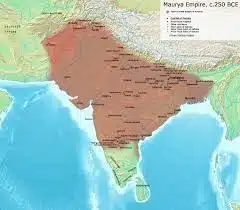
Mauryan Administration
The Mauryan period was marked by innovative administrative policies. The King was the fountainhead of all powers; though it is said that Mauryan kings, especially Ashoka, claimed paternal despotism rather than divine rule. In Arthashastra, the concept of Saptanga Rajya has been mentioned which means that a state comprises seven interrelated and interlocked angas or prakritis (elements). According to it, the seven limbs of a state are King, Amatya (Bureaucrats), Janapada (territory), Durga (Fort), Kosa (Treasure), Danda (coercive authority) and Mitra (ally).
- Mauryan State was the first welfare State in India.
- It was the most centralized State in Indian history.
- It was also the state with well expanded and structured bureaucracy.
Central Administration:
- At the Central level, the king was assisted by Council of Ministers called Mantri Parishad.
- Mantris were the advisors, who received 12,000 panas per annum as salary.
- There were 27 departments with 26 Adhyakshyas. The only department without Adhyaksha was Fisheries.
- Important functionaries were called Teerthas
- a) Samaharta was the Chief Tax Collector.
- b) Sannidata was the Chief Treasury Officer.
Provincial Administration:
- Empire was divided into 5 provinces – South, East, West, Central and Kalinga.
- Ujjain was the capital of Central Province.
- Taxila was the capital of Western Province.
- Suvarnagiri was the capital of Southern Province whose Governor was stated to be successor of the Mauryan State.
- Tosali was the capital of Eastern Province.
- Dhauli was the capital of Kalinga Province.
- Governors were called Kumara-amatyas.
- They were assisted by:
- Pradesika – Chief Revenue Officer.
- Rajuka – Revenue Settlement Officer.
- Yukta – Tax Collector.
- Sthanika was the Head of the Local Administration.
Judicial administration:
- The source of law for Mauryans was Sukraneeti written in post – Vedic age.
- Dharmasteyas were Civil Courts of Law and Kantakasodhakas were Criminal Courts.
- Emissariat (Spy system) or espionage formed a crucial part of Maurayan administration: The Chief royal spy was called Pathivedaka (one who reports directly to the king) and the other spies were called Gudapurusha.
- The Pradeshtris were the officers responsible for the suppression of criminals.
Revenue Administration:
The state appointed 27 Adyakshas (Superintendents) mostly to regulate the economic activities of the state.
They controlled and regulated agriculture, trade and commerce, weights and measures, crafts such as weaving and spinning, mining, etc.
- Land revenue was the major source of income.
- Peasants had to pay one-sixth of the produce as bhaga and the extra tax bali as tribute.
- Peasants had to pay many other taxes like Pindakara (assessed on a group of villages), Hiranya (paid only in cash), Kara (levied on fruits and flower gardens), etc.
- The class of officials who collected land tax was called Agranomoi (Megasthenes).
- However, there is no reference in any text of taking away the land of the farmers in case of non-payment of taxes.
- Kautilya also mentions certain emergency taxes (Pranaya) or the additional taxes that the state could impose if the treasury got depleted.
- Chief source of revenue was Land Tax or Bhaga. However many additional taxes were also levied:
- Hulivakara – Tax on ploughshare.
- Dasamolibaga – Tax collected by the State for protecting the crops from 10 types of destructions.
- Seetha or Sita – Land of State or the Crown lands which were administered by Seethadhyaksha.
- Forced labour called Vetti/Visti was employed on these lands. The officer-in-charge who took care of such labour was called Vistivandaka.
Mauryan agriculture had two types of landholdings.
- Rashtra Type
- This type of land holding was the direct descendant of the holding of the former tribal oligarchies who had been subjugated in pre-Mauryan times.
- The Rashtra landholding was to a large extent independent of the state machinery in their internal functioning and administration.
- Their only obligation was the regular payment of the Rashtra taxes to the state.
- Sita Type
- This type was formed by clearing forestland with the help of the tribesmen. This clearing up of forests opened contacts with tribes in areas still farther away.
- This was the beginning of the margin of the monarchical revenue system and of settled agriculture.
- The state maintained a close control over the state owned Sita land which could not be sold or transferred without special permission.
- This land was not made the property of the cultivator. It was leased to him for his lifetime and he could hold the lease on condition that he cultivated the land and paid taxes.
- The penalty for non-cultivation was confiscation of the leased land.
- Craft activities were also an important source of revenue to the state.
- Artisans living in the town had to pay taxes either in cash or kind or work free for the king (visthi- forced labour).
- There is mention of karamakara who were regarded as free labourers working for a regular wage and the dasas who were slaves.
- Traders and artisans were organised into corporate associations called shrenis or guilds or puga to protect their rights and these guilds were headed by Jesthaka.
- The state-run textile workshops were placed under Sutradhyaksha and chariot workshops under a Rathadhyaksha.
- Mining and metallurgy were other important economic activities and the mine officer was called Akaradhyaksha.
- The Mauryans maintained a monopoly over the production of iron, which was in great demand by the army, industry and agriculture. The officer-in-charge was named Loha-adhyaksha.
- Panya adhyakshya was Quality Controller of essential commodities.
- Potwa adhyakshya was incharge of weights and measures.
THE GUILD SYSTEM
- Srenis were the guilds of craftsmen and merchants.
- All trades were classified into different Srenis headed by a Srenin.
- Each of these guilds was guided by a set of regulations and norms. Srenidharma was the Code of Conduct of the guilds.
- Except for the guilds of Pataliputra, other guilds issued private Currencies.
CURRENCY SYSTEM:
- The punch-marked silver coins, carrying the symbols of the peacock, hill and the crescent (called pana) formed the imperial currency.
- Kautilya refers to the state officer-in-charge of coinage as Rupadarshaka.
- About the practice of usury, Megasthenes states that Indians neither put out money at usury (lending of money at high-interest rates) nor knew how to borrow.
COMMUNICATION SYSTEM:
- Most important highway was from Pataliputra to Taxila.
- Highway from Ujjain to Kanyakumari was called Dakshinavarta marga.
- Ujjain was the nodal point of all communication and transport system.
EXTERNAL TRADE:
- Broach (also called Bharukacha or Berigaza) was the most important city in the West.
- Tamralipti was the most important port on the East coast.
Mauryan Art and Sculpture
Decline of the Mauryas
The Mauryan empire began to decline after the death of Ashoka around 232 BCE. One of the reasons for its decline was the succession of weak kings. The last Mauryan king, Brihadratha was assassinated by his general Pushyamitra Shunga who was a Brahmin.
There are several reasons of declining of the Mauryan Dynasty. Some of them are as follows:
- Immediately after the death of Asoka, the Mauryan dynasty was partitioned into two parts viz. east and west. This partition disturbed the unity of the empire.
- The successors of Asoka were weak rulers and they appeared to not been able to handle the highly centralized tradition of domestic policy of the early Mauryas.
- Some scholars say that pious policy of Asoka was responsible to the decline of the empire as it undermined the strength of the empire. Some scholars contradict this theory because Asoka only left policy of annexation but never dissolved or weakened his army.
- Some scholars say that a Brahminical revolution was a reason of decline; however it is not accepted because Asoka, though patronized Buddhism, but never forced his religion on others.
- Some scholars say that there was a pressure on Mauryan economy, which is evident from the low quality punch marked coins in the later Maurya period. However, this idea is not adopted because foreign accounts give details of a flourished economy.
- Some scholars such as Romila Thapar say that Mauryan administration was highly centralized and only a prudent ruler could handle this machinery.
- Some scholars hold the oppressive policy of the later Mauryan for decline of the empire. Whatever may be the reason, one thing is clear that Maurya Administration was Highly centralized administration.
| INDUS VALLEY CIVILIZATION | Sites Of Indus Valley Civilization |
| Vedic Period | Vedic Literature |
| Marriages In the Later Vedic Period | MCQs: History Of Ancient India |

